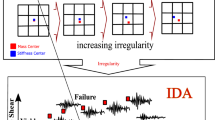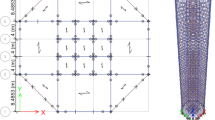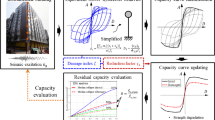Abstract
Many buildings in the present-day scenario have irregularities due to the discontinuity of their mass, stiffness, and geometry through their height. Buildings with vertical irregularities suffer severe damage as observed in past records. Structures situated in earthquake-prone regions are subjected to multiple earthquakes, occurring at a short interval of time, due to the mainshock–aftershock (MS–AS) sequence. This study investigates the effects of stiffness irregularities on the seismic performance of the 9-storey steel moment-resisting frame (SMRF) subjected to mainshocks and MS–AS. Nonlinear time-history analysis (NTHA) was conducted to compare the height-wise variation of maximum inter-storey drift ratio (IDR) demands of the regular and stiffness irregular frames. The results show that stiffness irregularity through the height of the frame influences the height-wise variation of inter-storey drift. Also, the structural responses of regular and irregular frames subjected to MS–AS are increased compared to mainshocks. This study also evaluates the accuracy of previously proposed three different equivalent single-degree-of-freedom systems (ESDOF) for obtaining seismic demands of multi-degree-of-freedom (MDOF) systems of regular and irregular frames subjected to mainshocks and MS–AS. The mean values of the height-wise variation of IDR obtained from MDOF and ESDOF systems are compared. The effectiveness of ESDOF systems for estimation of IDR is examined by mean bias and standard deviation of the ratio of mean values of IDR determined by NTHA of MDOF systems to the values determined by ESDOF systems. The study concludes ESDOF systems are useful for estimating the height-wise variation of IDR for regular and stiffness irregular frames subjected to mainshocks and MS–AS.












Similar content being viewed by others
References
Al-Ali AAK, Krawinkler H (1998) Effects of vertical irregularities on seismic behavior of building structures. Report No. 130, John A. Blume Earthquake Engineering Center, Stanford University, Stanford, CA
Aschheim M, Black E (1999) Effects of prior earthquake damage on response of simple stiffness-degrading structures. Earthq Spectra 15(1):1–24
Azghandi RR, Shakib H, Zakersalehi M (2020) Numerical simulation of seismic collapse mechanisms of vertically irregular steel high-rise buildings. J Constr Steel Res 166:105914
Chintanapakdee C, Chopra AK (2003) Evaluation of modal pushover analysis using generic frames. Earthq Eng Struct Dynam 32(3):417–442
Chintanapakdee C, Chopra AK (2004) Seismic response of vertically irregular frames: response history and modal pushover analyses. J Struct Eng 130(8):1177–1185
Chopra AK, Goel RK (2002) A modal pushover analysis procedure for estimating seismic demands for buildings. Earthq Eng Struct Dynam 31(3):561–582
Fragiacomo M, Amadio C, Macorini L (2004) Seismic response of steel frames under repeated earthquake ground motions. Eng Struct 26(13):2021–2035
Ghosh S, Collins KR (2006) Merging energy-based design criteria and reliability-based methods: exploring a new concept. Earthq Eng Struct Dynam 35(13):1677–1698
Ghosh S, Datta D, Katakdhond AA (2011) Estimation of the Park-Ang damage index for planar multi-storey frames using equivalent single-degree systems. Eng Struct 33(9):2509–2524
Gupta A, Krawinkler H (1998) Seismic demands for performance evaluation of steel moment resisting frame structures. Report No. 132; John A Blume Earthquake Engineering Center, Department of Civil and Environmental Engineering, Stanford University, Stanford, CA
Han R, Li Y, van de Lindt J (2014) Assessment of seismic performance of buildings with incorporation of aftershocks. J Perform Constr Facil 29(3):04014088
Han SW, Chopra AK (2006) Approximate incremental dynamic analysis using the modal pushover analysis procedure. Earthq Eng Struct Dynam 35(15):1853–1873
Hatzigeorgiou GD, Liolios AA (2010) Nonlinear behaviour of RC frames under repeated strong ground motions. Soil Dynam Earthq Eng 30(10):1010–1025
International Code of Council (2006) International Building Code. Whittier, CA
Kashkooli NA, Banan MR (2013) Effect of frame irregularity on accuracy of modal equivalent nonlinear static seismic analysis. KSCE J Civil Eng 17(5):1064–1072
Lee K, Foutch DA (2004) Performance evaluation of damaged steel frame buildings subjected to seismic loads. J Struct Eng 130(4):588–599
Li Q, Ellingwood BR (2007) Performance evaluation and damage assessment of steel frame buildings under main shock–aftershock earthquake sequences. Earthq Eng Struct Dynam 36(3):405–427
Lin JL, Tsaur CC, Tsai KC (2019) Two-degree-of-freedom modal response history analysis of buildings with specific vertical irregularities. Eng Struct 184:505–523
Loulelis D, Hatzigeorgiou GD, Beskos DE (2012) Moment resisting steel frames under repeated earthquakes. Earthq Struct 3(3–4):231–248
Mahin SA (1980) Effects of duration and aftershocks on inelastic design earthquakes. Proc., World Conf. on Earthquake Engineering, International Association for Earthquake Engineering (IAEE), Tokyo, Japan
Michalis F, Dimitrios V, Manolis P (2006) Evaluation of the influence of vertical irregularities on the seismic performance of a nine-storey steel frame. Earthq Eng Struct Dynam 35(12):1489–1509
Nazri FM, Miari MA, Kassem MM, Tan CG, Farsangi EN (2019) Probabilistic evaluation of structural pounding between adjacent buildings subjected to repeated seismic excitations. Arab J Sci Eng 44(5):4931–4945
Nazri FM, Tan CG, Saruddin SNA (2018) Fragility curves of regular and irregular moment-resisting concrete and steel frames. Int J Civil Eng 16(8):917–927
Oyguc R, Toros C, Abdelnaby AE (2018) Seismic behavior of irregular reinforced-concrete structures under multiple earthquake excitations. Soil Dynam Earthq Eng 104:15–32
Parekar SD, Datta D (2020) Seismic behaviour of stiffness irregular steel frames under mainshock–aftershock. Asian J Civil Eng 21:857–870
Pirizadeh M, Shakib H (2013) Probabilistic seismic performance evaluation of non-geometric vertically irregular steel buildings. J Constr Steel Res 82:88–98
Prasanth T, Ghosh S, Collins KR (2008) Estimation of hysteretic energy demand using concepts of modal pushover analysis. Earthq Eng Struct Dynam 37(6):975–990
Raghunandan M, Liel AB, Luco N (2014) Aftershock collapse vulnerability assessment of reinforced concrete frame structures. Earthq Eng Struct Dynam 44(3):419–439
Ribeiro FL, Barbosa AR, Neves LC (2014) Application of reliability-based robustness assessment of steel moment-resisting frame structures under post-mainshock cascading events. J Struct Eng 140(8):A4014008
Ruiz-Garcia J (2012) Mainshock-aftershock ground motion features and their influence in building’s seismic response. J Earthq Eng 16(5):719–737
Ruiz-Garcia J, Aguilar JD (2017) Influence of modeling assumptions and aftershock hazard level in the seismic response of post-mainshock steel framed buildings. Eng Struct 140:437–446
Ruiz-Garcia J, Negrete-Manriquez JC (2011) Evaluation of drift demands in existing steel frames under as-recorded far-field and near-fault mainshock–aftershock seismic sequences. Eng Struct 33(2):621–634
SAC 95-04 (1995) Analytical and field investigations of buildings affected by the Northridge earthquake of January 17, 1994, Technical Report; SAC Joint Venture Partnership, Parts 1 and 2, Sacramento, CA
SAP2000 (2012) Static and dynamic finite element analysis of structures. Version 14.2.4, Berkeley (CA): Computers and Structures Inc
Somerville P, Smith N, Punyamurthula S, Sun J (1997) Development of ground motion time histories for phase II of the FEMA/SAC steel project. Report No. SAC/BD-97/04, SAC Background Document, Richmond, CA
Sunasaka Y, Kiremidjian AS (1993) A method for structural safety evaluation under mainshock-aftershock earthquake sequences. John A Blume Earthquake Engineering Center, Stanford CA
Valmundsson EV, Nau JM (1997) Seismic response of building frames with vertical structural irregularities. J Struct Eng 123(1):30–41
Varadharajan S, Sehgal VK, Saini B (2012) Review of different structural irregularities in buildings. J Struct Eng 39(5):393–418
Venture VJ (2000) FEMA 355 state of the art report on systems performance of steel moment frames subject to earthquake ground shaking. Rep. No. FEMA-355C
Zhai CH, Wen WP, Chen Z, Li S, Xie LL (2013) Damage spectra for the mainshock–aftershock sequence-type ground motions. Soil Dynam Earthq Eng 45:1–12
Zhai CH, Wen WP, Li S, Chen Z, Chang Z, Xie LL (2014) The damage investigation of inelastic SDOF structure under the mainshock–aftershock sequence-type ground motions. Soil Dynam Earthq Eng 59:30–41
Zhang Y, Chen J, Sun C (2017) Damage-based strength reduction factor for nonlinear structures subjected to sequence-type ground motions. Soil Dynam Earthq Eng 92:298–331
Acknowledgement
Not applicable.
Funding
Not applicable.
Author information
Authors and Affiliations
Corresponding author
Ethics declarations
Conflict of Interest
On behalf of all authors, the corresponding author states that there is no conflict of interest.
Rights and permissions
About this article
Cite this article
Parekar, S.D., Datta, D. Evaluation of seismic performance of steel frames with stiffness irregularity subjected to mainshock–aftershock using equivalent single-degree-of-freedom system. Innov. Infrastruct. Solut. 6, 76 (2021). https://doi.org/10.1007/s41062-020-00442-4
Received:
Accepted:
Published:
DOI: https://doi.org/10.1007/s41062-020-00442-4




